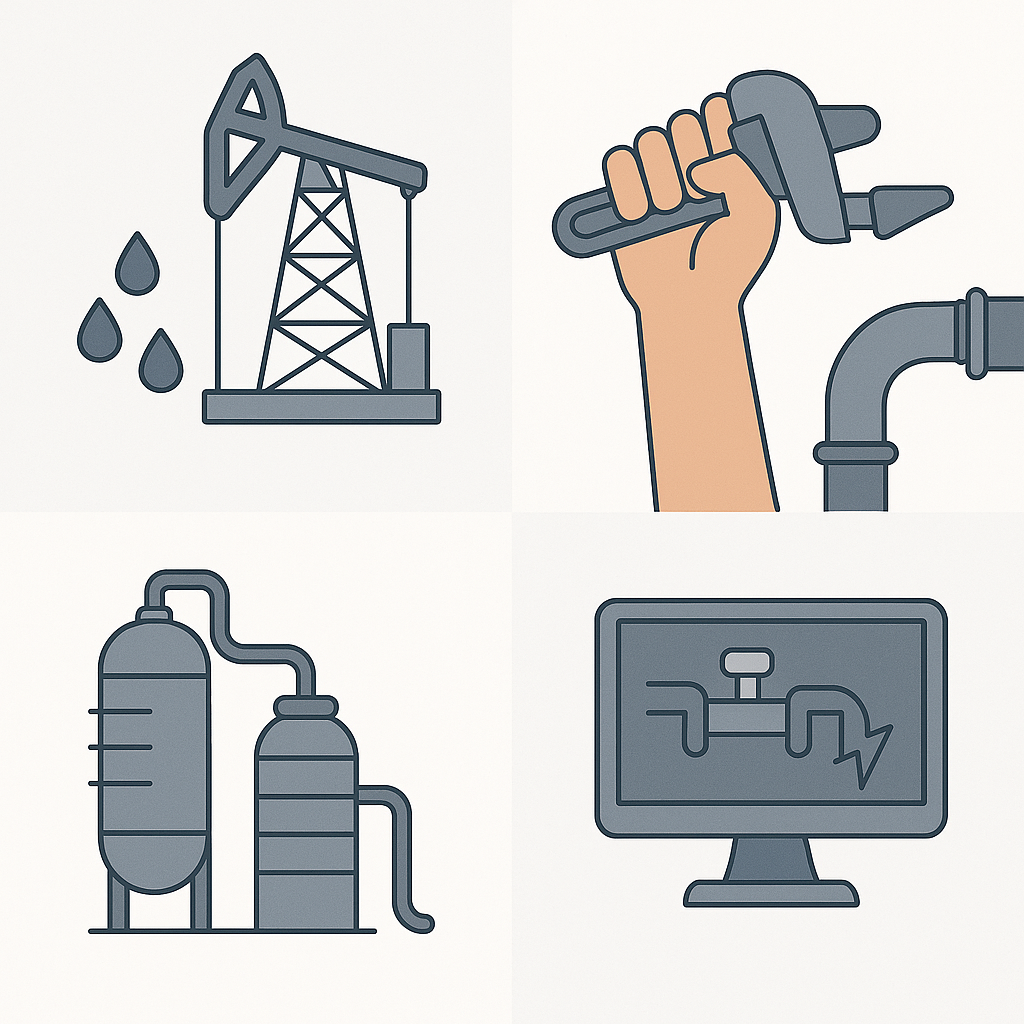Drive innovation in upstream, midstream and downstream energy. Oil & gas companies and associated petrochemical operations across the U.S. are developing new drilling technologies, refining processes, digital controls, and material systems. Many of these initiatives qualify for the federal R&D Tax Credit under IRC §41, along with state‑level incentives.


Examples of qualifying activities in oil & gas
- Advanced Extraction & Drilling Technologies Development of automated drilling rigs, advanced bit or sensor systems, new down‑hole tools or directional drilling methods.
- Refining & Petrochemical Process Innovation Testing new catalyst systems, improved refinery units, novel separation processes for crude, or new polymer feedstock formulations tied to petrochemical operations.
- Pipeline, Containment & Transportation Systems Designing new containment systems, improved pipeline monitoring or leak‑detection technologies, advanced pumping or compressor systems.
- Automation, Sensors & Digital Control Systems Implementing AI‑driven process control, real‑time monitoring of wells or upstream operations, digital twin modelling of facilities.
- Sustainability & Environmental Mitigation Projects Developing vent‑recovery systems, CO₂ capture or reuse projects in upstream operations, novel materials for corrosion control and enhanced recovery.
What qualifies as R&D in Oil & Gas?

To qualify, activities must:
- Pursue a permitted purpose such as designing a new extraction tool, refining process, pipeline system or digital control method
- Address technical uncertainty about method, capability or design in petroleum engineering, materials science, chemical process, or automation
- Follow a process of experimentation through pilot programs, test wells, process modelling, or control‑system trials
- Be technological in nature, grounded in petroleum engineering, chemistry, materials engineering, or industrial automation
Qualified Research Expenses (QREs)
Roles commonly involved in qualifying activities
- Petroleum and reservoir engineers
- Process and chemical engineers (refinery and petrochemicals)
- Automation and digital‑control specialists
- Materials engineers testing novel steels, coatings, or composites for drilling/transport
- External research partners, labs, and pilot‑plant facilities
What does not qualify
- Routine production of oil or gas without experimentation
- Standard maintenance or operations of drilling/refining assets without technical advancement
- General administrative, sales or marketing tasks
- Land acquisition or conventional production equipment not tied to research
Compliance and Documentation
Following the One Big Beautiful Bill Act (OBBBA) signed July 4, 2025, §174 now allows immediate expensing of domestic research expenses for tax years beginning on or after January 1, 2025. Taxpayers may also elect optional amortization under new §174A. Foreign research expenses must still be amortized over 15 years. This is separate from the §41 credit but impacts overall tax planning.
- Project goals, hypotheses, test well or process‑trial frameworks
- Pilot logs, sensor data, modelling outputs, failure analysis
- Comparative metrics (baseline vs improvement)
- Employee time tracking and role descriptions tied to experimentation
- Audit‑ready demonstration of the four‑part test
Frequently Asked Questions


Yes — if they conduct drilling, refining, transportation or material/process innovations rather than routine operations.


Wages of engineers and technicians, pilot‑plant supplies, simulation software, contract research in labs or field trials.


Upstream (drilling/extraction), mid‑stream (transportation/pipelines), downstream (refining/petrochemicals) when actively testing new methods.


Routine production, non‑technical tasks, standard asset wear‑and‑tear, and equipment purchases not tied to research.


Savings depend on project scope and size; companies can claim a portion (commonly ~22 %) of qualified research expenses.


Maintain logs of test wells, drilling parameter iterations, modelling data, sensor or automation trials, engineering drawings, and employee time sheets.
Next Steps
Use our calculator to estimate your potential federal and state benefits
Schedule a consultation to structure your row crop research activities
If you are innovating in agriculture, you may already be doing R&D. Let's make sure you are rewarded for it.
Contact Strike Tax Advisory
Ready to maximize your R&D tax credits? Get in touch with our team of experts.

Manufacturing
With just a little info, our Strike Experts can help you start your R&D tax credit journey.
Got questions?
We’ll walk you through our process and take the time to understand yours to make sure you get the most back.
Schedule a MeetingRelated Sub-Industries
Does your state qualify for the State R&D Tax Credit?
Benefits for the R&D Tax Credit vary from state to state. Get an accurate estimate of your potential state tax credit!






